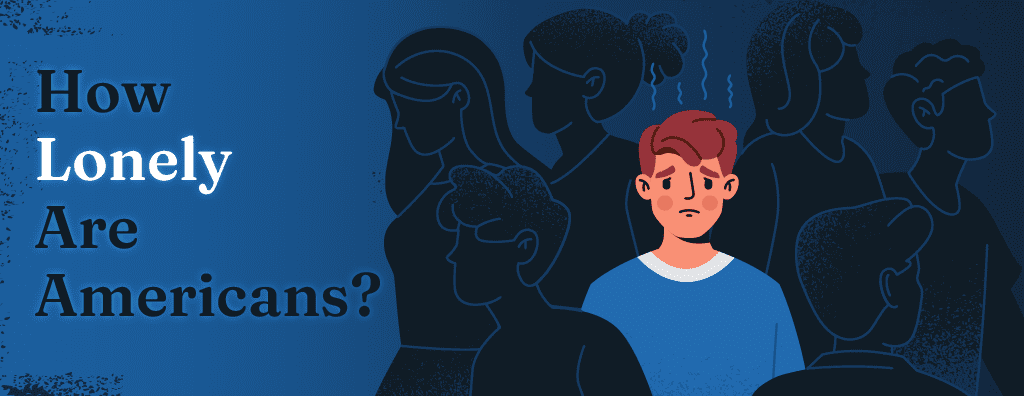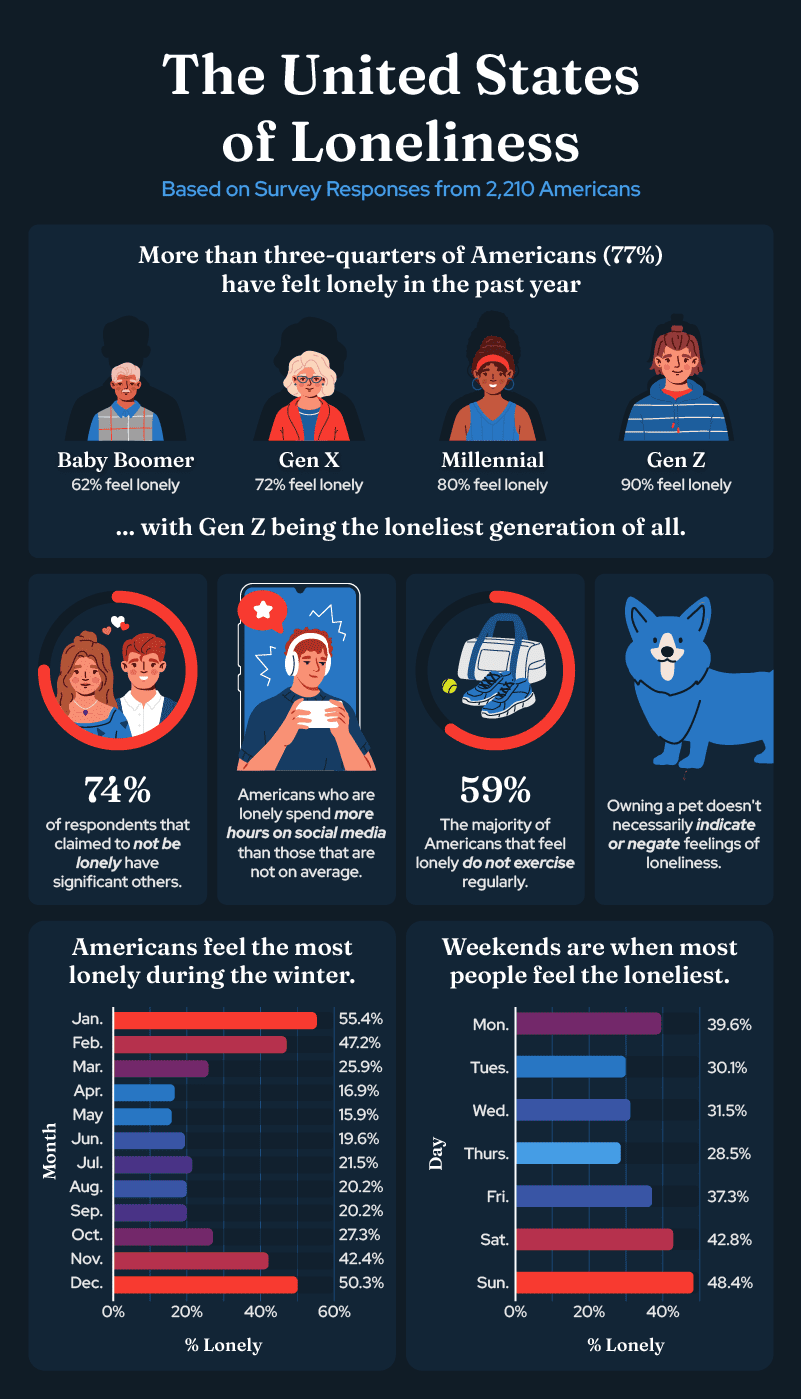
Across the U.S., there is a silent epidemic that can affect anyone and everyone: loneliness. The concept of loneliness has evolved beyond the stereotypical image of solitude. Loneliness entangles itself into our social interactions, mental health, and lifestyle choices. This evolution calls for a deeper understanding of how loneliness looks in today’s society, how it affects various groups differently, and what measures we can take to address this growing concern.
To determine how loneliness has affected Americans of all ages and backgrounds, we conducted a survey to find out just that. Read on to discover just how prevalent loneliness is in the U.S.
Table of Contents
Key Findings
- In the past year, an alarming 77% of Americans have experienced feelings of loneliness, with Generation Z emerging as the most affected demographic.
- Of those who feel lonely, the majority (59%) said they do not engage in regular physical activity, highlighting the link between mental and physical wellness. Poor mental health can impact overall energy levels, making it harder to regularly exercise.
- According to our findings, there’s a notable trend where Americans who spend more time on social media report higher levels of loneliness, suggesting that online interactions may not be enough socialization to combat loneliness.
- Among those feeling lonely, men are more likely to seek out relationships than women as a coping mechanism.
- The role of pets in addressing loneliness is complex. Pet ownership does not necessarily equate to reduced feelings of loneliness.
The Loneliest States of All

At the top of the loneliness scale is Nevada, with a score of 82.20 out of 100, making it the most lonely state in the U.S. Residents of Nevada have reported feeling an overwhelming sense of isolation, a trend that is on the rise in 2023.
Colorado follows with a score of 74.57 out of 100, joining Nevada as one of the states where residents, on average, feel more lonely than not. A common thread in both states is the lack of proximity to family and friends, highlighting the impact of physical distance on emotional well-being.
On the other side of the scale, Maine stands as the least lonely state, with a score of just 35.40 out of 100. The low levels of loneliness here may be partially attributed to the fact that a majority of residents report having a significant other.
Nebraska and Florida also feature among the least lonely states, with scores of 35.52 and 41.05 out of 100, respectively. Florida with its vibrant social scenes and a sense of belonging, showcases the power of community and relationships in combating loneliness.
Loneliness in America

Our comprehensive survey examining the state of loneliness in America uncovered several patterns that shed light on the factors that may influence feelings of isolation among Americans.
A significant finding is the correlation between having a significant other and experiencing loneliness. Approximately 74% of respondents who reported not feeling lonely were in a relationship, suggesting that intimate partnerships offer substantial emotional support.
In addition, those who feel lonely and also spend more time on social media reported higher levels of loneliness. In contrast, those who feel lonely and spend less time on social media reported lower levels of loneliness. This suggests that social media usage could exacerbate feelings of loneliness, or that digital connections do not necessarily lessen feelings of loneliness offline.
Diving deeper, we analyzed whether time spent socializing impacted feelings of loneliness. People who do not feel lonely interact with others for about 3.6 hours per day, surprisingly less than the 4.6 hours spent by their lonelier counterparts. This suggests that the quality of social interactions might be more crucial than their duration in combating feelings of isolation.
The same principle seems to apply to socializing with our furry friends. While having a pet can provide companionship, it does not conclusively determine one’s loneliness level, according to our findings.
The survey also uncovers patterns in when Americans feel the loneliest. Sundays, Saturdays, and Mondays are the days most associated with loneliness, while the winter months of January, December, and February are the loneliest time of the year. This seasonal and weekly trend could reflect the effects of a variety of factors, like increased pressure around the holidays, shorter daylight hours, stretched year-end budgets, and more.
Notably, three-quarters of Americans feel the loneliest at home, highlighting the importance of creating a living environment that fosters connectivity and belonging. To manage loneliness, Americans turn to activities such as watching TV, browsing social media, playing games, napping, and spending time with pets.
Closing Thoughts
As we unpack the various facets of loneliness in America, it becomes evident that this issue is more than just a fleeting emotion; it’s a significant aspect of our overall well-being. At a time when we are beginning to view health holistically, understanding and addressing the mental health component is vital.
Prolonged loneliness has been associated with an increased risk of developing various illnesses. Research suggests that social isolation may contribute to mental health issues and chronic conditions, emphasizing the importance of meaningful social connections for overall well-being.
Assurance IQ’s mission is to help people improve and protect their personal and financial well-being. We help people find health insurance plans that meet their unique needs. Some health plans, including some types of Medicare Advantage Plans, offer benefits that can help address loneliness, like mental health care and companion care services that provide human connection and support.
This component is essential in today’s world where mental health is as significant as physical health. In a time where loneliness is on the rise, having access to mental health resources through health insurance is a step towards fostering a more connected society.
Methodology
To determine which states were the most and least lonely, we conducted a survey in November 2023. We surveyed every state with questions that could affect loneliness (from companionship, activities, and level of socialization, to name a few). We then evenly weighted each question to give every state analyzed a score out of 100 (1 being not lonely and 100 being completely lonely) based on their results. It’s worth noting that due to their lower populations, we did not receive enough responses from Alaska, Montana, North Dakota, South Dakota, Vermont, and Wyoming to include.
